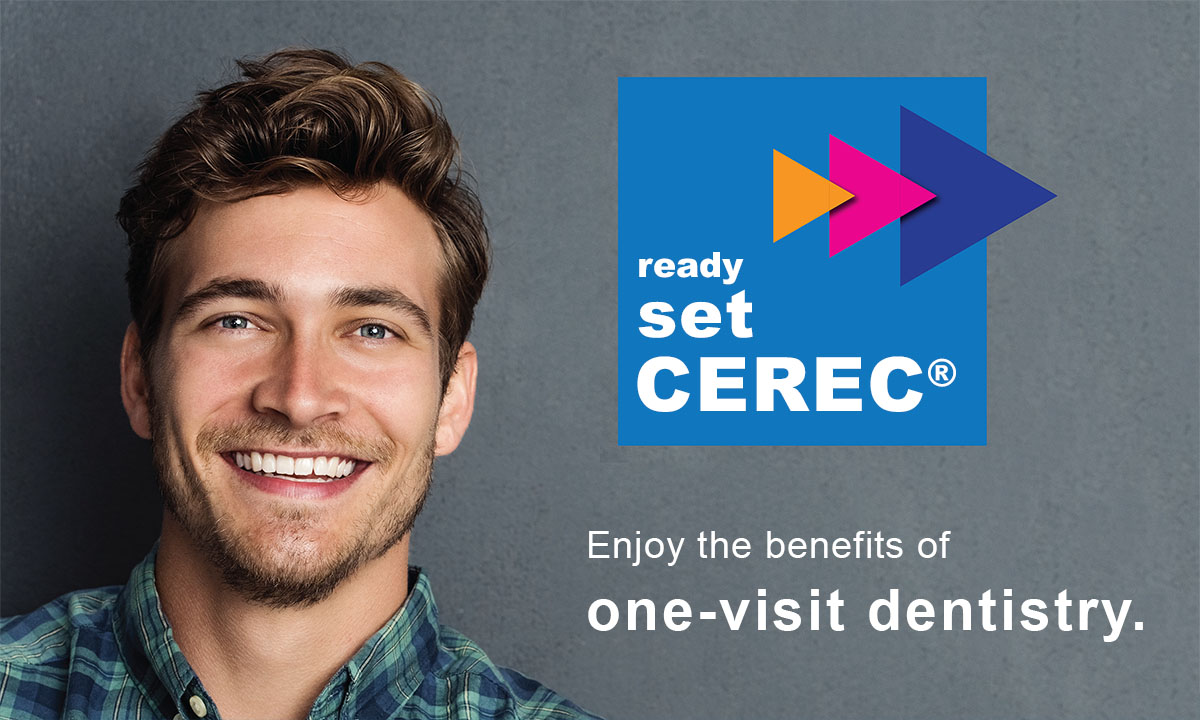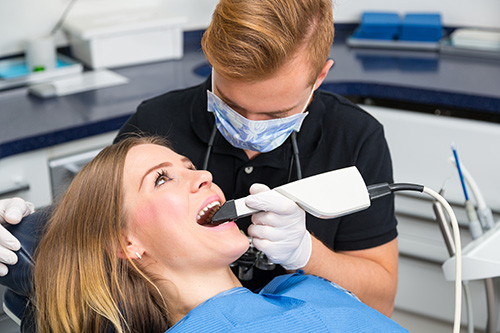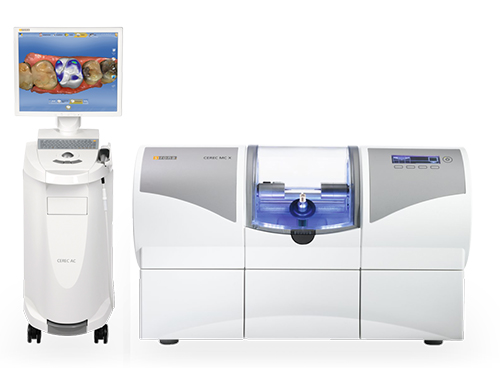We speak English, Spanish and Portuguese
We speak English, Spanish and Portuguese

CEREC is a chairside CAD/CAM system that allows dentists to design, mill, and place all-ceramic restorations in a single appointment. Rather than sending impressions to a laboratory and waiting for multiple visits, this workflow streamlines treatment so patients leave with a finished, polished restoration the same day. The emphasis is on combining clinical accuracy with patient-centered convenience.
Because CEREC restorations are fabricated from high-quality ceramic blocks, they offer strong, lifelike results that integrate well with natural teeth. The system is compatible with crowns, inlays, onlays, and certain veneer-type restorations, making it a flexible option for addressing a variety of restorative needs.
Beyond speed, CEREC supports conservative dentistry. The precise digital planning and milling often enable more exact fits and less removal of healthy tooth structure compared with more traditional techniques, helping preserve long-term tooth health.

One of the most immediate benefits for patients is the reduction in appointments. With a CEREC workflow, preparation, digital scanning, design, milling, and placement all happen during the same visit. That means no temporary crowns, no impression material held in your mouth for extended periods, and no waiting weeks for the lab to return a final restoration.
This efficiency also minimizes interruptions to daily life. Whether you're balancing work, school, or family responsibilities, receiving a final restoration in a single appointment reduces time away from routine activities while delivering results that restore chewing function and aesthetics immediately.
Because the final restoration is fabricated and fitted on-site, adjustments can be made promptly. The dentist can evaluate the restoration's fit, shape, and shade in real time and refine it before cementation so you leave with a comfortable, polished result.

CEREC brings several technologies together: an intraoral scanner to capture precise 3D images, intuitive design software to shape the restoration, and a high-speed milling unit that carves the restoration from a ceramic block. Each step is driven by digital accuracy, which reduces sources of error and improves the consistency of the final fit.
Digital scanning eliminates the need for traditional impression trays for many patients. The scanner captures detailed surface anatomy and occlusal relationships, feeding that data into the design program where the clinician refines contours and contacts with visual precision.
Once the design is finalized, the milling machine fabricates the restoration to the exact dimensions specified. Advances in ceramic materials and milling technology mean restorations are strong, color-stable, and highly resistant to wear when properly cared for.

CEREC restorations are milled from medical-grade ceramic blocks selected for their strength and translucency. These materials mimic the way natural enamel reflects light, producing an esthetic result that blends with adjacent teeth. Color matching and surface characterization further refine the look so the restoration appears seamless in everyday use.
Durability depends on appropriate material selection, precise fit, and patient habits, but contemporary ceramics used with CEREC are engineered to withstand normal biting forces for many years. Routine dental care, avoiding hard impacts, and addressing any parafunctional habits help extend the life of the restoration.
Because the material is metal-free, CEREC ceramic restorations are often an excellent choice for patients seeking a biocompatible, highly natural-looking solution that resists staining and maintains its esthetic qualities over time.

Your visit begins with an evaluation and treatment plan tailored to your needs. If a CEREC restoration is appropriate, the tooth is prepared and an intraoral scan replaces conventional impressions. The digital model appears on screen so you can see the proposed restoration and discuss shape, color, and fit with your dentist before any milling takes place.
While the restoration is milled chairside, the clinical team may place a temporary protective measure if needed—often the milled restoration is ready for final adjustments and bonding within the same appointment. The dentist will check occlusion and polish the surface for both comfort and aesthetics before cementing the restoration permanently.
After placement, you'll receive specific care instructions to protect your new restoration. Follow-up care typically includes routine hygiene visits and any necessary maintenance checks. This predictable, streamlined process supports excellent outcomes and a strong long-term prognosis for the treated tooth.
When a dental office integrates digital restorative technology into its workflow, patients gain access to more predictable treatment outcomes and a smoother overall experience. A practice skilled with CEREC can efficiently move from diagnosis to final restoration while maintaining clinical standards for fit, form, and function.
Choosing a provider with experience in digital workflows helps ensure the restoration is planned with a full understanding of occlusion, neighboring teeth, and esthetic goals. At Inspirational Smiles, our clinical team emphasizes careful planning, precise execution, and ongoing preventive care to help each restoration perform well over time.
If you’re exploring options for a crown, inlay, or onlay and value both quality and convenience, consider asking about CEREC during your next dental visit. Contact us for more information or to discuss whether same-day ceramic restorations are a good fit for your dental needs.
Today, there's no need to merely imagine how nice it would be to have a dental crown fabricated in a single visit. With CEREC technology and advanced systems of care, multiple trips to the dentist are a thing of the past! Now, one appointment is all it takes for our skilled and experienced dentist to design, fabricate, and place a naturally beautiful and long-lasting same-day crown. And, best of all, unlike conventional methods of care, you won't have to endure messy dental impressions, wear a temporary crown, or wait weeks for your permanent restoration to come back from the laboratory.
Offering a level of precision and comfort that exceeds conventional methods of care, CEREC technology is nothing short of amazing! Advanced CAD/CAM technology, which stands for computer-aided design and computer-aided manufacturing, enables our dentist to translate images from an optically scan tooth into a 3D virtual model upon which a custom crown can be digitally designed. Once this step is done, the detailed specs are then wirelessly transmitted to a chairside 3D milling machine to fabricate your new ceramic crown while you wait!
With conventional methods of care, a dental crown can take two to three visits to fabricate and place. However, thanks to the benefits of CEREC technology, we can prepare a tooth, then design, fabricate, and place your new crown, all while you wait.
With CEREC same-day crowns, there's none of the mess of conventional dental impressions, wearing dental temporaries, or waiting for the final crown to come back from the lab. Once the prepared tooth is optically scanned and the restoration digitally designed, your new crown can be milled from the highest quality of dental ceramics that very same visit.
CEREC same-day crowns and restorations are fabricated from the highest quality of dental ceramics. Because dental porcelain reflects light in much the same way as dental enamel, your new crown will look flawless, completely natural, and blend seamlessly with your smile.
A CEREC same-day crown offers much more than a convenient approach to getting a dental crown. It is also a high quality, naturally beautiful, extremely durable, and long-lasting dental restoration! The fact is, with proper oral hygiene and routine dental care your new crown will serve your smile well for many years to come.
CEREC is a chairside CAD/CAM system that lets a clinician design, mill and place an all-ceramic restoration in a single visit. Using an intraoral scanner the dentist captures a precise 3D image of the prepared tooth, which is then translated into a digital model. Design software allows the clinician to shape contours and contacts before the restoration is milled from a ceramic block.
A high-speed milling unit carves the restoration to the exact dimensions specified in the digital design, producing a finished ceramic piece that can be adjusted and bonded the same day. This workflow reduces laboratory steps while maintaining clinical accuracy through digital planning and controlled fabrication. The result is a restoration that combines convenience with predictable fit and esthetics when executed by an experienced team.
CEREC is commonly used for single-unit crowns, inlays, onlays and certain veneer-type restorations that require precise ceramic fabrication. The system can also produce implant crowns and small bridgework in appropriate cases, depending on clinical complexity and occlusal demands. Material choices and preparation design help determine which type of restoration is best suited for a patient’s needs.
Because restorations are milled from medical-grade ceramic blocks, they offer a lifelike appearance and strong physical properties suitable for many restorative indications. Clinicians may select different ceramic formulations to balance translucency, strength and polishing characteristics for each case. Your dentist will recommend the most appropriate restoration type based on tooth condition, bite relationships and aesthetic goals.
A typical CEREC appointment for a single restoration often takes a few hours from start to finish, although exact timing varies with case complexity. The visit begins with an evaluation and tooth preparation followed by a digital scan that replaces conventional impressions for many patients. The doctor then uses design software to shape the restoration while you review contours, contacts and shade on screen.
Once the design is approved, a chairside milling unit fabricates the ceramic restoration, which is then finished, polished and fitted for precise occlusion. Small adjustments can be made immediately before the restoration is permanently bonded, eliminating the need for a temporary crown in most cases. The result is a completed restoration delivered within the same appointment with immediate restoration of function and aesthetics.
Ideal candidates are patients who need single-unit restorations and who have adequate remaining tooth structure and stable bite relationships. Patients seeking a metal-free, esthetic option or who prefer to minimize multiple visits often benefit from same-day ceramic restorations. Good oral hygiene and regular dental care contribute to successful outcomes with CEREC restorations.
Certain clinical situations, such as extensive tooth loss, uncontrolled bruxism or very complex multi-unit restorations, may require alternative workflows or laboratory collaboration. Your dentist will evaluate medical history, occlusion and restorative needs to determine whether a CEREC restoration is the best choice. A personalized exam and treatment planning session will clarify candidacy and expected results before proceeding.
Modern CEREC ceramics are engineered for strength and wear resistance and can withstand normal chewing forces when properly matched to the clinical situation. Longevity depends on material selection, precise fit and how the restoration is used in the mouth. Avoiding habits such as biting hard objects and addressing grinding or clenching helps protect the restoration over time.
Daily brushing with a nonabrasive toothpaste and regular flossing around the restoration preserve both esthetics and periodontal health. Routine dental visits allow the clinician to check margins, occlusion and any signs of wear so small issues can be managed early. Following your dentist’s specific home care recommendations and attending follow-up exams contribute significantly to long-term success.
Shade selection begins with the clinician assessing surrounding teeth under controlled lighting and choosing the best ceramic block to match color and translucency. Digital tools and in-office staining or glazing techniques allow clinicians to fine-tune surface characterization and luster before final placement. Because the restoration is fitted chairside, the dentist can evaluate and refine shade and anatomy in real time for an integrated appearance.
Advanced ceramics mimic the way natural enamel reflects light, creating lifelike results when characterized correctly and polished to the proper finish. In complex esthetic cases your dentist may recommend additional layering or laboratory options, but many routine anterior and posterior restorations achieve excellent results with CEREC. Open communication about shade preferences and photographs of your natural teeth can help the team deliver a restoration that meets your expectations.
Yes, most CEREC restorations are fabricated from metal-free ceramic materials that are well tolerated by oral tissues and widely used in restorative dentistry. Ceramic restorations eliminate concerns related to metal corrosion and reduce thermal conductivity compared with metal-containing alternatives. For patients with documented metal allergies or sensitivities, ceramic options are often a favorable solution pending individual evaluation.
Biocompatibility also depends on proper bonding protocols and clean clinical technique to ensure a secure, sealed restoration. Your dentist will review your medical and dental history to confirm the best material choice and to address any allergy questions before proceeding. When placed correctly, ceramic restorations provide a stable, long-lasting option that integrates well with surrounding tissues.
CEREC is commonly used to fabricate single implant crowns and custom abutments when digital impressions and implant workflows are compatible with the clinical situation. Small-span bridges and multi-unit restorations can be possible in select cases, but they require careful planning and may involve additional laboratory or technical steps. Factors such as implant position, occlusion and the need for screw-retained versus cemented designs influence whether a chairside approach is appropriate.
Complex full-arch or long-span prosthetics often benefit from a combined digital and lab-based workflow to ensure optimal strength and passivity. Your dentist will discuss the recommended approach during treatment planning and explain when in-office milling is suitable versus when laboratory collaboration is preferable. A tailored plan ensures that implant restorations meet both functional and esthetic goals for your smile.
Digital scanning and precise milling allow clinicians to design restorations that require minimal removal of healthy tooth structure compared with more aggressive traditional techniques. Improved marginal fit and accuracy reduce the need for extensive adjustments or re-preparation, which helps preserve enamel and dentin. This conservative approach supports the long-term strength and vitality of treated teeth when combined with appropriate restorative planning.
Because designs are evaluated on-screen before milling, dentists can plan conservative margins and optimal contact points that maintain periodontal health and function. Conservative restorations also simplify future maintenance and potential repairs, making subsequent care less invasive. When preservation of natural tooth structure is a priority, a CEREC workflow offers predictable options that align with minimally invasive dentistry principles.
At Inspirational Smiles our team combines digital technology with clinical experience to provide same-day ceramic restorations tailored to each patient’s needs. You can expect a thorough evaluation, clear explanations of treatment options and the opportunity to view and approve the restoration design before milling. Our clinicians use intraoral scanning, precision milling and careful finishing to deliver restorations that restore function and aesthetics efficiently.
We speak English, Spanish and Portuguese and strive to make each visit comfortable and informative so patients understand both the procedure and aftercare. After placement you will receive personalized instructions for home care and recommended follow-up so the restoration can perform well over time. If concerns arise, our team will review the restoration and occlusion to make any necessary adjustments and support long-term success.

Looking to schedule your next dental visit or learn more about our services?
Getting in touch with Inspirational Smiles is simple! Our caring team is ready to help with appointment scheduling, questions about treatments, or any concerns you may have. You can call us or use our easy online contact form—whatever works best for you.
Take the first step toward a healthier, more confident smile today and experience the difference that personalized, compassionate dental care can make.